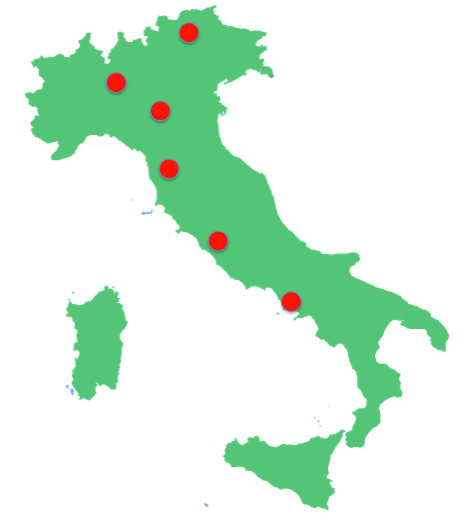Scientific activities of the various Research Units
Roma I
The Rome group activity focuses on the study of gravitational wave signals emitted by neutron stars and black holes, aiming at comparing our predictions with the signals detected by LIGO and Virgo. We study how to extract information on the equation of state of matter in the interior of a neutron star from a detected waveform from coalescing binaries. In addition we study the signatures that modified theories of gravity leave on the signal emitted in the coalescence of two black holes or two extremely compact objects predicted by these theories; these have to be compared with the detected signals to prove, or disprove, the validity of general relativity in the strong gravity, high curvature regime.
Firenze
In the Florence group we make use of numerical modeling to investigate the structure and dynamics of magnetized NSs, which are sources of high-energy electromagnetic emission and gravitational waves. This research is based on a collaboration between the University of Florence and the local Astrophysical Observatory (INAF). Numerical simulations in General Relativistic Magnetohydrodynamics allow us to compute the structure of compact objects (a dedicated code, XNS, is freely available: www.arcetri.astro.it/science/ahead/XNS/), and to study the interaction of their magnetized, ultrarelativistic winds with the surroundings, namely the expanding supernova ejecta, giving rise to the synchrotron emitting pulsar wind nebulae.
Milano Bicocca
The Milan group studies the formation and growth of massive black holes in the cosmological context, and the formation of stellar-origin black holes in star clusters. Our research aims at providing the scientific ground for the LISA interferometer in space, selected by ESA for L3. Following the discovery of GW150914, the group is also active in developing strategies for detecting the electromagnetic signal of LIGO-Virgo events, and in particular of neutron star mergers. Using state-of-the-art SPH and direct N-body simulations, we study how massive black holes can form from stellar-origin black holes, through accretion events or dynamical instabilities in ultra dense star clusters, and how massive black holes coalesce as galaxies merge.
Napoli
The research activity of the Napoli group is based on the study of NSs and compact objects in the framework of alternative theories of gravity. Analytical and numerical solutions can be derived in order to set self-consistent mass-radius diagrams. Indications on new NS branches seem confirmed by observational data coming from peculiar objects as PSR J1614-2230. Besides, binary pulsars provide excellent sources to test GR in the strong-field regime. Alternative theories could allow to explain the gap between data and theoretical estimations (e.g. the orbital decay). In particular, we are interested in computing post-Keplerian parameters, to estimate the masses of binary systems and to constrain analytic parameters of alternative theories.
Parma
The activity of the Parma group is about modeling the coalescence of compact binaries, with the goal of characterizing the emitted gravitational wave signal. One of the main focus of the research is the study of the inspiral, merger and post-merger signal from binary neutron stars, that is necessary for extracting the information about the equation of state of matter at the extreme densities from the observations. The research methods span from analytical and perturbative techniques, such as the effective-one-body framework, to the development of numerical relativity techniques and the use of high-performance-computing simulations.
TIFPA
The Trento group works on numerical simulations, in full general relativistic hydrodynamics and magnetohydrodynamics, of compact objects such as NSs and BHs. The Trento group studies both the GW and electromagnetic emission generated during the merger of binary NSs and of binary SMBHs. Binary NS mergers are very powerful sources of GWs that will be detected by advanced Virgo and advanced LIGO; they are also thought to be behind the central engine of short gamma-ray bursts. SMBH are instead formed after the merger of galaxies and the Trento group studies the possible electromagnetic emission that these objects could generate during merger.
^ Back to Top


